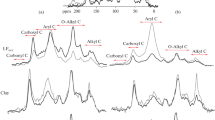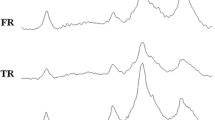Abstract
The molecular composition of soil organic matter (SOM) of two calcareous soils highly rich in carbonates was assessed before and after decarbonation by acid washing with HCl through 13C-CPMAS-NMR spectroscopy and off-line thermochemolysis coupled with gas chromatography and mass spectrometry (THM-GC-MS). The acidic treatment promoted a considerable concentration of organic matter in both soils, thus improving the identification of molecules otherwise not easily detectable. Decarbonation induced only a slight loss of soil organic carbon (SOC), corresponding to 1.4 and 2.7% for A and B soils respectively. The acidic treatment also led to an increase in the organic carbon/total nitrogen (OC/N) ratio in soil A, while an opposite variation was found for the second soil. Moreover, variations in the concentration and molecular distribution of specific compound classes present in SOM were caused by the acid washing of soils. As confirmed by both 13C-CPMAS-NMR and thermochemolysis results, the molecules most susceptible to the acid treatment were the carbohydrates, lignin monomers (G14 and G15), fatty acids (C18 saturated and unsaturated), fatty acids of microbial origin (C15, C17, and C19), hydroxy acids (C16, C18), and dioic acids (C18) which represent the components weakly bound to the organic matrix. Our findings not only showed the efficacy of the decarbonation treatment of calcareous soils with 3 N HCl, but also indicated how the acidic washing can improve the differentiation of soils on the basis of SOM molecular characteristics.

Graphical abstract




Similar content being viewed by others
References
Lal R. Soil carbon sequestration impacts on global climate change and food security. Science. 2004;304(5677):1623–7.
Puglisi E, Fragoulis G, Del Re AAM, Spaccini R, Piccolo A, Gigliotti G, et al. Carbon deposition in soil rhizosphere following amendments with compost and its soluble fractions, as evacuate by combined soil-plant rhizobox and reporter gene system. Chemosphere. 2008;73:1292–9.
Spaccini R, Song XY, Cozzolino V, Piccolo A. Molecular evaluation of soil organic matter characteristics in three agricultural soils by improved off-line thermochemolysis: the effect of hydrofluoric acid demineralisation treatment. Anal Chim Acta. 2013;802:46–55.
Piccolo A, Spaccini R, Drosos M, Vinci G, Cozzolino V. The molecular composition of humus carbon: recalcitrance and reactivity in soils. In: Garcia C, Nannipieri P, Hernandez T, editors. The future of soil carbon. Its conservation and formation. Cambridge: Academic Press; 2018. p. 87–124.
Piccolo A. The nature of soil organic matter and innovative soil managements to fight global changes and maintain agricultural productivity. In: Piccolo A, editor. Carbon sequestration in agricultural soils. Heidelberg: Springer Verlag; 2012. p. 1–20.
Quenea K, Largeau C, Derenne S, Spaccini R, Bardou G, Mariotti A. Molecular and isotopic study of lipids in particle size fractions of a sandy cultivated soil (Cestas cultivation sequence, southwest France): sources, degradation, and comparison with Cestas forest soil. Org Geochem. 2006;37:20–44.
Helfrich M, Flessam H, Mikutta R, Dreves A, Ludwig B. Comparison of chemical fractionation methods for isolating stable soil organic carbon pools. Eur J Soil Sci. 2007;58:1316–29.
Canellas LP, Spaccini R, Piccolo A, Dobbss LB, Okorokova-Facanha AL, Santos GD, et al. Relationships between chemical characteristics and root growth promotion of humic acids isolated from Brazilian oxisols. Soil Sci. 2009;174:611–20.
Nebbioso A, Piccolo A. Basis of a humeomics science: chemical fractionation and molecular characterization of humic biosuprastructures. Biomacromolecules. 2011;12:1187–99.
Spaccini R, Piccolo A. Molecular characterisation of compost at increasing stages of maturity: II. Thermochemolysis-GC-MS and 13C-CPMAS-NMR spectroscopy. J Agric Food Chem. 2007;55:2303–11.
Šmejkalová D, Spaccini R, Piccolo A. Multivariate analysis of CPMAS 13C-NMR spectra of soils and humic matter as a tool to evaluate organic carbon quality in natural systems. Eur J Soil Sci. 2008;59:496–504.
Spaccini R, Piccolo A. Molecular characteristics of humic acids extracted from compost at increasing maturity stages. Soil Biol Biochem. 2009;41:1164–72.
Schmidt MWI, Knicker H, Hatcher PG, Kogel-Knabner I. Improvement of 13C and 15N CPMAS NMR spectra of bulk soils, particle size fractions and organic material by treatment with 10% hydrofluoric acid. Eur J Soil Sci. 1997;48:319–28.
Sanchez-Monedero MA, Roig A, Cegarra J, Bernal M, Paredes C. Effects of HCl–HF purification treatment on chemical composition and structure ofhumic acids. Eur J Soil Sci. 2002;53:375–81.
Gonçalves CN, Dalmolin RSD, Dick DP, Knicker H, Klamt E, Kögel-Knabner I. The effect of 10% HF treatment on the resolution ofCPMAS 13C NMR spectra and on the quality oforganic matter in Ferralsols. Geoderma. 2003;116:373–92.
Keeler C, Maciel GE. Quantitation in the solid-state 13C NMR analysis of soil and organic soil fractions. Anal Chem. 2003;75:2421–32.
Faure P, Schlepp L, Mansuy-Huault L, Elie M, Jarde E, Pelletier M. Aromatization of organic matter induced by the presence of clays during flash pyrolysis-gas chromatography–mass spectrometry (PyGC–MS). A major analytical artifact. J Anal Appl Pyrolysis. 2006;75:1–10.
Simpson MJ, Simpson AJ, Kingery WL. Solid-state 13C nuclear magnetic resonance (NMR) analysis of soil organic matter. Reference Module in Earth Systems and Environmental Sciences. 2017. https://doi.org/10.1016/B978-0-12-409548-9.10275-1.
Midwood AJ, Boutton TW. Soil carbonate decomposition by acid has little effect on the 13C or organic matter. Soil Biol Biochem. 1998;30:1301–7.
Ramnarine R, Voroney RP, Wagner-Riddle C, Dunfield KE. Carbonate removal by acid fumigation for measuring the d 13 C of soil organic carbon. Can J Soil Sci. 2011;91:247–50.
Min-Seob K, Won-Seok L, Suresh KK, Kyung-Hoon S, Wayne R, Minseok K, et al. Effects of HCl pretreatment, drying, and storage on the stable isotope ratios of soil and sediment samples. Rapid Commun Mass Spectrom. 2016;30:1567–75.
Bisutti I, Hilke I, Raessler M. Determination of total organic carbon – an overview of current methods. Trends Anal Chem. 2004;23:716–26.
Chatterjee A, Lal R, Shrestha RK, Ussiri DAN. Soil carbon pools of reclameminesoils under grass and forest landuses. Land Degrad Dev. 2009;20:300–7.
Rumpel C, Rabia N, Derenne S, Quenea K, Eusterhues K, Kogel-Knabner I, et al. Alteration of soil organic matter following treatment with hydrofluoric acid (HF). Org Geochem. 2006;37:1437–51.
Sleutel S, Leinweber P, Begun SA, Kader MA, De Neve S. Shifts in soil organic matter composition following treatment with sodium hypoclorite and hydrofluoric acid. Geoderma. 2009;149:257–66.
Walkley A, Black IA. An examination of Degtjareff method for determining soil organic matter and a proposed modification of the chromic acid titration method. Soil Sci. 1934;37:29–37.
Monda H, Cozzolino V, Vinci G, Spaccini R, Piccolo A. Molecular characteristics of water-extractable organic matter from different composted biomasses and their effects on seed germination and early growth of maize. Sci Total Environ. 2017;590-591:40–9.
Bird MI, Giresse P, Chivas AR. Effect of forest and savanna vegetation on the carbon-isotope composition of sediments from the Sanaga River, Cameroon. Limnol Oceanogr. 1994;39:1845–54.
Loeppert RHH, Suarez DLL. Carbonate and Gympusm. In: Methods of soil analysis. Part 3. Chemical methods—SSSA. Madison: Soil Science Society of America and American Society of Agronomy; 1996. p. 455–6.
Schubert CJ, Nielsen B. Effects of decarbonation treatments on δ13C values in marine sediments. Mar Chem. 2000;72:55–9.
Deshmukh AP, Simpson AJ, Hadad CM, Hatcher PG. Insights into the structure of cutin and cutan from Agave americana leaf cuticle using HRMAS NMR spectroscopy. Org Geochem. 2005;36:1072–85.
Hatcher PG, Nanny MA, Minard RD, Dible SD, Carson DM. Comparison of two thermochemolytic methods for the analysis of lignin in decomposing gimnosperm wood: the CuO oxydation method and the method of thermochemolysis with tetramethylammonium hydroxide (TMAH). Org Geochem. 1995;23:881–8.
Inbar Y, Chen Y, Hadar Y. Solid-state carbon-13 nuclear magnetic resonance and infrared spectroscopy of composted organic matter. Soil Sci Soc Am J. 1989;53:1695–701.
Zhou P, Pan GX, Spaccini R, Piccolo A. Molecular changes in particulate organic matter (POM) in a typical Chinese paddy soil under different long-term fertilizer treatments. Eur J Soil Sci. 2010;61:231–42.
Vane CH, Martin SC, Snape CE, Abbott GD. Degradation of lignin in wheat straw during growth of the oyster mushroom (Pleurotus ostreatus) using off-line thermochemolysis with tetramethylammonium hydroxyde and solid state 13C NMR. J Agric Food Chem. 2001;49:2709–16.
Filley TR, Hatcher PG, Shortle WC, Praseuth RT. The application of 13C-labeled tetramethylammonium hydroxide (13C-TMAH) thermochemolysis to the study of fungal degradation of wood. Org Geochem. 2000;31:81–198.
Acknowledgements
This work was supported by the Commissariat pour l’Energie Atomique (CEA) of France.
Author information
Authors and Affiliations
Corresponding authors
Ethics declarations
Conflict of interest
The authors declare that they have no conflict of interest.
Additional information
Publisher’s note
Springer Nature remains neutral with regard to jurisdictional claims in published maps and institutional affiliations.
Electronic supplementary material
ESM 1
(PDF 101 kb)
Rights and permissions
About this article
Cite this article
Vinci, G., Mazzei, P., Bridoux, M. et al. Molecular characterization of organic matter in two calcareous soils: the effects of an acid decarbonation treatment. Anal Bioanal Chem 411, 5243–5253 (2019). https://doi.org/10.1007/s00216-019-01903-1
Received:
Revised:
Accepted:
Published:
Issue Date:
DOI: https://doi.org/10.1007/s00216-019-01903-1




